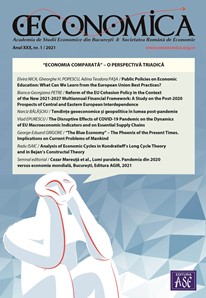
The Romanian Government’s Underwhelming Response to the COVID-19 Crisis
A month and a half since the declaration of a state of emergency and after almost a dozen lockdown military ordinances took effect in the country, broadly in line with the policy of most other European countries, a brief evaluation is in order.
The Romanian Government’s response to the COVID-19 crisis has nothing exceptional, no original idea, no single individualized policy, no special or particular focus. If Sweden, no matter how controversial, dared to pursue an individualized strategy of keeping the country open so as to achieve a higher degree of immunity as well as minimize economic loss and social distress, or if Germany implemented a swift search-and-clean infection-cluster policy followed-up by an effective intensive care capacity and real-time viral research, Romania has simply copy-pasted some broad European and World Health Organization lockdown guidelines to stop the contagion risk. There is no active – in some cases even experimental – strategy, no special health care crisis unit, no real-time research and goal oriented policy – just a rather ridiculously named “Group of Strategic Communication”, made up mostly of police and intelligence officers, which releases some basic statistics concerning the number of people infected, those hospitalized, confined or dead to some press outlets and, with long lags, publishes them on the website of the Ministry of Internal Affairs.
State of exception
The lockdown policy was implemented in Romania on March 23rd through a constitutional mechanism called the “state of emergency”, which is distinct but vaguely defined from a “state of siege” in the country’s supreme law. Nevertheless, the military, or more precisely the Defence Ministry, took the upper hand in the crisis response. All the lockdown orders have, curiously enough, been issued through “military ordinances”. But, from a constitutional point of view, it is still not clear if the state of emergency had to be implemented through military ordinances, which some people – although hardly all, particularly in a country such as Romania, where civil institutions lack public confidence – may not find reassuring. Other than cleaning – or disinfecting – some roads outside a highly affected city in the north of the country, the practical involvement of the military in the health crisis response has so far resembled more a sort of Hollywood-type distraction, since public civility is not yet at risk and has been handled by the police and gendarmerie as usual. Although particular military-led assistance might theoretically be necessary in some special cases, there does not seem to be any general need for it. So far, the consumer economy’s supply chains have not been overwhelmed, nor has there been any need for military camp-type hospitals. A country which could not produce enough vaccines to fight ordinary contagious diseases before the crisis, like smallpox and influenza, can only provoke an ironic laughter when it parks some barely repainted or, sometimes, still in desert paint military Humvees from NATO missions in Afghanistan in the main squares of its capital.
This is not to say that the lockdown measures had no absolute effect in limiting the contagion. To the extent that they did, as the compartmental epidemiological models on which they are based imply, it is something that will have to be clarified on an international scale wherever such policies have been put in place. What is already clear, however, is that the effect of the Romanian government’s implemented policy in this crisis is so far limited or quite disappointing compared to the rest of the countries in the region with similar implemented policies and socio-economic characteristics concerning the risk of contagion.
These characteristics include low or concentrated human mobility composed mainly of workers in Western Europe who show up in the country on holidays, while the contagion began to spread a month or so after Christmas. Eastern European countries are also less densely populated and less urbanized than Western European countries, which, in terms of prevailing epidemiological thinking, might translate into in-built, spatialized “social distancing”, reducing the transmission rate R0. All of these countries currently exhibit a much lower rate of infection than the countries of Western Europe, usually below 0.10%, as opposed to around 0.35%, according to World Health Organization (WHO) data. The rate of mortality in the infected population is generally also lower in the Eastern as oppose to the West of Europe by as much as factor of 5, although there is considerable variation in the latter group of countries and possible delayed effects in the former. Countries such as Germany, Denmark and Switzerland have a relatively low mortality rate and a high recovery rate of patients hospitalized, while countries such as France, Spain and Italy have a high mortality rate and a relatively low recovery rate. All things considered, these days life suddenly does not seem that bad in Eastern Europe.
Criticizing the response
Nevertheless, the Romanian Government’s response relative to these other neighbouring countries has not been very effective if judged by results and the current data. A country such as Poland, for instance, with almost twice the population of Romania, reports, as of May 4th, 13,693 persons infected compared to 13,163 in Romania and a significantly lower number of deaths (678 vs. 780)! In light of this telling comparison, anyone thinking of praising the Romanian Government should think twice. Its anti-pandemic performance is underwhelming, even embarrassing. With an infection rate of 0.068%, almost twice the rate of Poland (0.036%) Romania is currently the third most infected country in the Eastern part of the EU and the largest of them, behind only Czechia (0.072%) and Estonia (0.128%). Even among candidate countries in the region, only Serbia and Turkey report a higher infection rate (0.108% and 0.153%, respectively). In short, the Romanian Government has failed to successfully control the epidemic relative to its neighbours. Praises might be bestowed on a country like Greece, which for whatever reasons registers surprisingly only 2,626 infected individuals and 144 deaths to date for a population of 10.4 million (infection rate 0.025%), while Romania should be nicknamed the Spain or Italy of Eastern Europe if the contagion numbers of the country were scaled down and properly compared to the region as a whole!
Almost everything the Romanian government has done so far – and this was a case when creative government should have been at its peak – represents a form without substance and it has basically no results to show above the region’s baseline – quite the contrary! The crisis response has been led by the same antiquated, passive, unresponsive public administration which for three decades has kept the country in a bottom European position in almost all other aspects. Its personnel can at best copy-paste some broad international policy, with no capacity for own ideas, a variable capacity to imitate or sometimes even fake and misconstrue fashionable or “best practice” policy recommendations, little or no prospective thinking, goal orientation, accountability or attention to details. A month and a half into the crisis, there is no government report, no lessons seem to have been learned, no check-list of objectives and results, no detailed investigation, basically no real public explanation, no sketch of a future strategy, no amendments, no new policy – just another Ctrl+C-Ctrl+V idea in line with Western continental Europe’s plans for a partial reopening beginning with the middle of May.

Not only the government, narrowly understood, is in this situation. In a public space infected by fake, semi-fake or low quality news and information, no research or emergency institution – although the country boasts several academies, more than eighty universities and a plethora of institutes of various kind, on top of various agencies, including a Civil Protection service that has been so far curiously muted when most needed; no research or emergency institution has so far been able to publish a detailed and credible investigation of how the contagion evolved, spread, will unfold. There is nothing more than the press stories of Romanians returning from Italy showing up in emergency rooms at hospitals.
In fact, in all official discussions about the contagion, the only medical professional with some visibility and credibility is a paramedic of Palestinian extraction, Raed Arafat, now a State Secretary in the Ministry of Internal Affairs, responsible precisely for coordinating the emergency response, who gained popularity by creating a new first aid ambulance service, SMURD, alongside the usual public ambulance service, which now functions as a division within the firefighting service. Unfortunately, since the COVID-19 crisis began he made himself noticed less for medical insight and expertise than for organizing the national quarantine in war-like fashion, for instance by assigning the Ministry of Internal Affairs’ intelligence officers in the crisis-rooms of local authorities to help with their knowledge and advice. The Romanian public health sector was mired in scandals, underfunding and inefficiency for years. Stories about patients going out of hospitals with bacteriological infections, medical malpractice rarely punished or acts of corruption were the order of the day before the crisis. None of the half a dozen new regional or county hospitals planned for construction have been built, or if some of them are built they have no equipment and are not operational. The National Virology Institute stopped producing antibodies some two years ago. Consequently, there is basically little or no hint of official research pursued to find some sort of cure – none of the medical research institutions or companies in the country seem to have the capacity or even the will to enter this global race. Salvation for those infected, if there is one, will come from elsewhere.
More to go around
In Romania, the security state has thus far been more prominent in combating the epidemic crisis than the medical apparatus. The emphasis was almost entirely on the quarantine decreed by exception and backed by military governance: presidential speeches distributed on social media, hundreds or thousands of billboards asking people to stay home, the show of military boots and police patrols in every half-deserted crossroad; gatherings, schools and all non-essential commercial activity were shut down. The expected results in containing the contagion, while difficult to assess counterfactually or discount entirely, fall behind most countries in the region. The doctors – also praised in cartoon fashion as heroes alongside the stay-at-home folk –, the medical experts and researchers seem almost completely absent. There is little-to-no news in the country of their advances in fighting and eventually ending the crisis, although this is – one has to repeat this – a health crisis first and foremost.
Without a contagion tree and up-to-date mapping designing an effective containment policy is virtually impossible. New research in France on tissue samples of a dead patient who, having done no travelling abroad in the previous six months, checked into a hospital in December last year and was misdiagnosed with a common flu already casts doubt on the idea that the epidemic spread from China in February this year. Without an institutionalized medical emergency and research unit – a task force which, at least theoretically, could have been assembled out of the Civil Protection’s biohazards units, SMURD crews, the medical universities and institutes virology experts and excess hospital personnel – acting on the ground and pursing real-time analysis, nothing can be learned, no active policy response can be devised by continuously revising increments of new knowledge – in the end, no permanent solution can be found. Without proactive medical research, doctors and nurses can only grapple with symptoms. Without mass-scale testing and swift intervention isolating the sick from the healthy the contagion cannot be contained. And without high-quality and creative intensive care for the sick few will be saved. None of the above are or have been a priority for the Romanian authorities and therefore the response to the outbreak is, in relative terms, a failure. Instead of tents offering masks and individual testing, the Romanian population got billboards imperatively advising them to stay home and policemen giving fines to persons walking without a superfluous piece of paper stipulating where they are going. Instead of medical personnel – of whatever agency or uniform – in the street they got some American-style looking soldiers showing off their cars and guns in city squares. In short, instead of receiving medical assistance and reassurance from the state, the people were ordered around and scared in old fashion quasi-authoritarian style. The whole response was more form than substance, as if the government’s unpreparedness and lack of creative, effective, targeted policies had to be hidden behind overnight martial decrees and half-empty solemn declarations.
In the end, the military can guard the hospitals until soldiers fall ill, people can stay locked inside until they have to be taken to the intensive care unit and, there, by chance, maybe a brilliant doctor or a dedicated nurse can make a difference in saving a life, but – in the absence of a coordinated medical-focused and research-based effort – no single doctor or a hundred doctors and nurses in general hospitals around the country can track the spread of the virus, gather or centralize all the data, isolate and systematically investigate all the samples or, even less, develop new treatments, drugs or vaccines and thus really put an end to the outbreak.
Conclusion
The lockdown policy cannot, obviously, last forever, without breaking down the whole social and economic structure. It is not a goal in itself. The Romanian economy is projected to contract by 6% this year following the COVID-19 supply shock, according to the European Commission. Unlike in the US, unemployment remains officially subdued for the moment, because a large part of the workforce is on paid leave or in “technical unemployment” – a legal concept in Romanian labour law designating a person who is still legally employed, but for independent reasons does not exercise the employment and is not paid the full salary; the Ministry of Public Finance plans to institute a moratorium on debts until the end of the year to prevent a debt crisis; and the National Bank of Romania lowered its interest rates by 0.5% to bolster credit lines and support demand. The artificial holiday is supposed to put a break on the contagion, and buy time to think up the next step in a sequence of events to eventually find a cure. It is doubtful that anyone in the Romanian Government, from top to bottom, has taken advantage of this more or less expedient policy to really think one step ahead. As the Western-oriented Romanian intelligentsia has always tacitly or implicitly thought, thanks God that Others will, willingly or not, think for the country as well!








